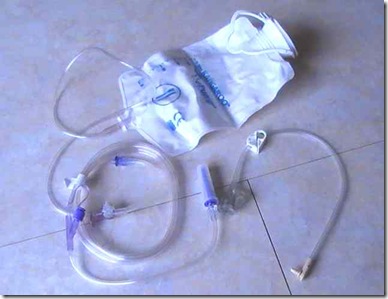Definition
Gastrostomy is a surgical procedure for inserting a tube through the abdomen wall and into the stomach. The tube, called a "g-tube," is used for feeding or drainage.Purpose
Gastrostomy is performed because a patient temporarily or permanently needs to be fed directly through a tube in the stomach. Reasons for feeding by gastrostomy include birth defects of the mouth, esophagus, or stomach, and neuromuscular conditions that cause people to eat very slowly due to the shape of their mouths or a weakness affecting their chewing and swallowing muscles.Gastrostomy is also performed to provide drainage for the stomach when it is necessary to bypass a longstanding obstruction of the stomach outlet into the small intestine. Obstructions may be caused by peptic ulcer scarring or a tumor.
Indications
Gastrostomy feeding tubes are put in for different reasons. They may be needed for a short while or permanently. This procedure may be recommended for:- Babies with birth defects of the mouth, esophagus, or stomach (for example, esophageal atresia or tracheal esophageal fistula)
- Patients who cannot swallow correctly
- Patients who cannot take enough food by mouth to stay healthy
- Patients who often breathe in food when eating
Demographics
In the United States, gastrostomies are more frequently performed on older persons. The procedure occurs most often in African-American populations.Description
Gastrostomy, also called gastrostomy tube (g-tube) insertion, is surgery performed to give an external opening into the stomach. Surgery is performed either when the patient is under general anesthesia—the patient feels as if he or she is in a deep sleep and has no awareness of what is happening—or under local anesthesia. With local anesthesia, the patient is awake, but the part of the body cut during the operation is numbed.Fitting the g-tube usually requires a short surgical operation that lasts about 30 minutes. During the surgery, a hole (stoma) about the diameter of a small pencil is cut in the skin and into the stomach; the stomach is then carefully attached to the abdominal wall. The g-tube is then fitted into the stoma. It is a special tube held in place by a disc or a water-filled balloon that has a valve inside allowing food to enter, but nothing to come out. The hole can be made using two different methods. The first uses a tube called an endoscope that has a light at the end, which is inserted into the mouth and fed down
For a percutaneous endoscopic gastrostomy procedure, the stomach is inflated with air (A). An incision is made into the abdomen and the stomach, and a plastic cannula is inserted (B). A catheter is inserted into the patient's mouth, pulled down the esophagus, and into the stomach (C). When the catheter is in place, access to the stomach is maintained (D). (Illustration by GGS Inc. )
the gullet (esophagus) into the stomach. The light shines through the skin, showing the surgeon where to perform the incision. The other procedure does not use an endoscope. Instead, a small incision is made on the left side of the abdomen; an incision is then made through the stomach. A small flexible hollow tube, usually made of polyvinylchloride or rubber, is inserted into the stomach. The stomach is stitched closely around the tube, and the incision is closed.
The length of time the patient needs to remain in the hospital depends on the age of the patient and the patient's general health. In some cases, the hospital stay can be as short as one day, but often is longer. Normally, the stomach and abdomen heal in five to seven days.
The cost of the surgery varies, depending on the age and health of the patient. Younger patients are usually sicker and require more intensive, and thus more expensive, care.

Patient education concerning use and care of the gastrostomy tube is very important. Patients and their families are taught how to recognize and prevent infection around the tube; how to insert food through the tube; how to handle tube blockage; what to do if the tube pulls out; and what normal activities can be resumed.
After the Procedure
This is most often a simple surgery with a good outlook.Outlook (Prognosis)
The stomach and abdomen will heal in 5 to 7 days. Moderate pain can be treated with medications. Feedings will start slowly with clear liquids, and increase slowly.The patient/family will be taught:
How to care for the skin around the tube
Signs and symptoms of infection
What to do if the tube is pulled out
Signs and symptoms of tube blockage
How to empty the stomach through the tube
How and what to feed through the tube
How to hide the tube under clothing
What normal activities can be continued
NURSING DIAGNOSES
Based on the assessment data, the major nursing diagnoses in the postoperative period may include the following:Imbalanced nutrition, less than body requirements, related to enteral feeding problems
Risk for infection related to presence of wound and tube
Risk for impaired skin integrity at tube site
Ineffective coping related to inability to eat normally
Disturbed body image related to presence of tube
Risk for ineffective therapeutic regimen management related to knowledge deficit about home care and the feeding procedure
No comments:
Post a Comment